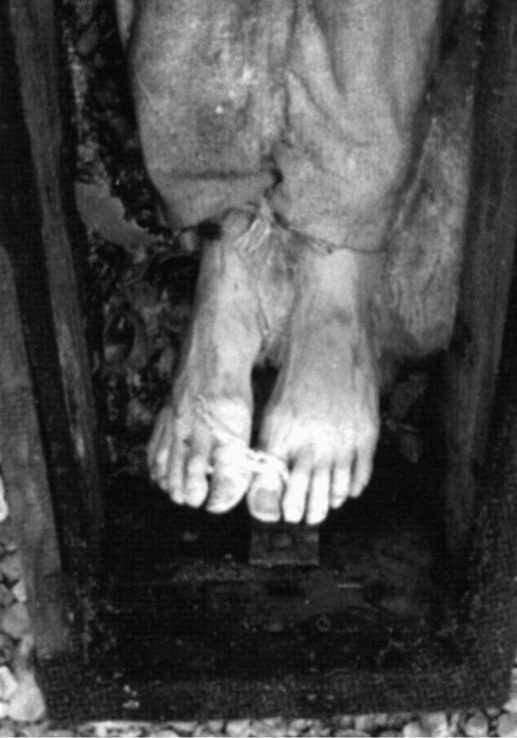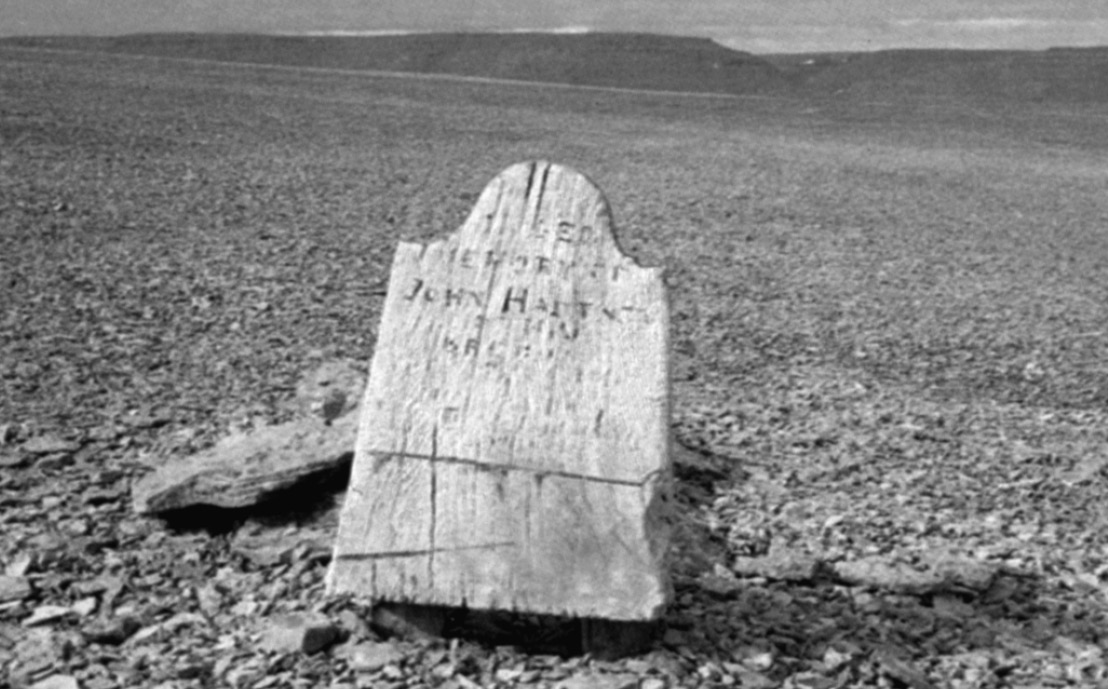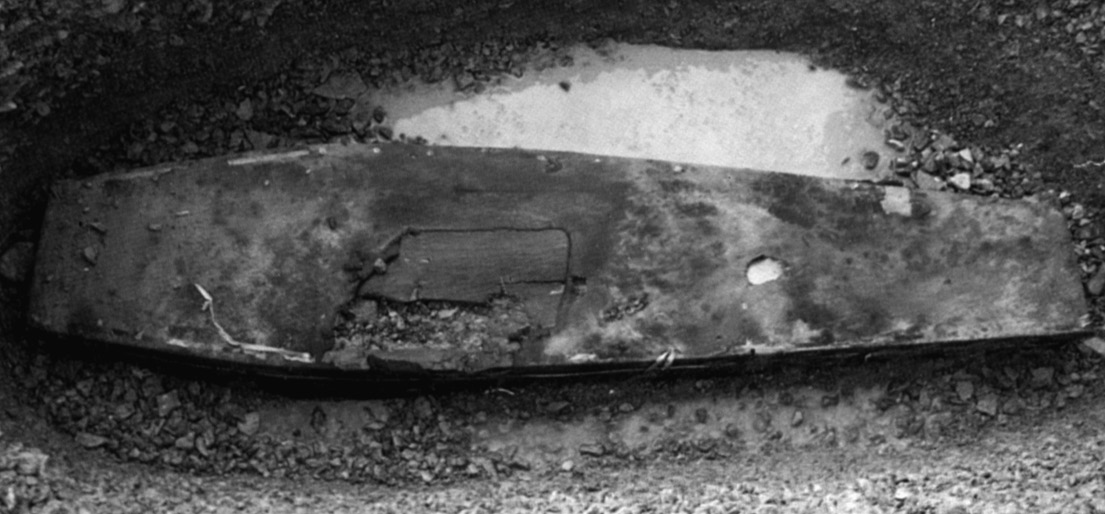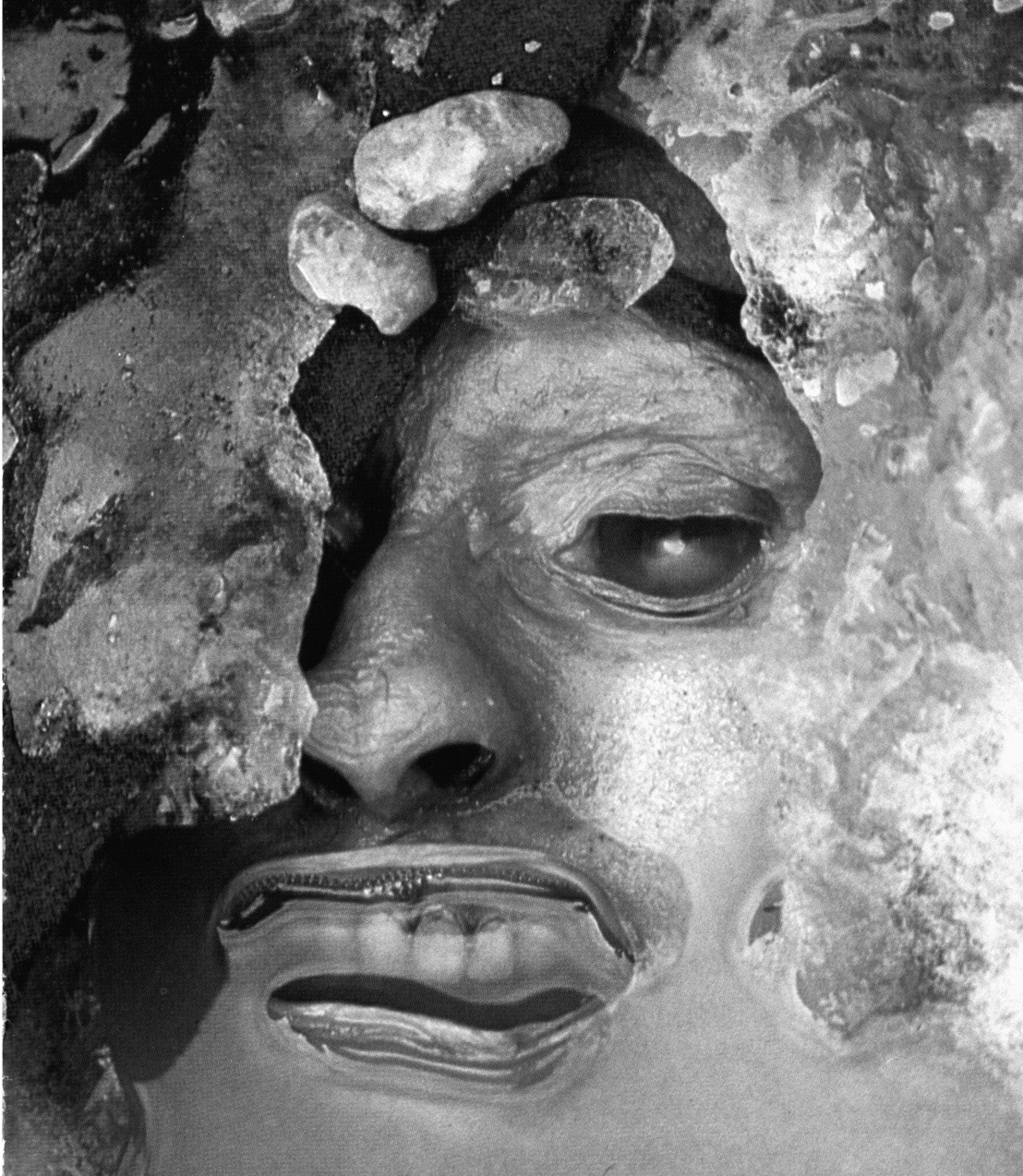Frozen in Time (18 page)


John Torrington: The body was bound with strips of cotton to hold the limbs together during preparation for burial.
Yet by far the strongest and most vivid memory Beattie has of this remarkable event centres not around the ï¬nal thawing of Torrington's body in the coffin, but on the lifting of the body out of the grave in preparation for autopsy. It was a remarkable and highly emotional experience, with Carlson holding and supporting Torrington's legs, Beattie his shoulders and head. He was very light, weighing less than 88 pounds (40 kg), and as they moved him his head lolled onto Beattie's left shoulder; Beattie looked directly into Torrington's half-opened eyes, only a few inches from his own. There was no rigidity of his body, and rigor mortis would have disappeared within hours of his death. Although his arms and legs were tightly bound, he was completely limp, causing Beattie to comment, “It's as if he's just unconscious.”
The two men carefully lowered Torrington to the ground outside the grave. There he lay, exposed to the Arctic sky for the ï¬rst time in 138 years. If he had miraculously stirred to consciousness after his long sleep, Torrington would have thought that he had missed just two changes of seasonâa sleep of but eight months.
The bindings were removed and the body undressed. Away from the reality of the research project, an observer might suggest that the undressing of the body was an indignity to Torrington. But given the situation, both the need for medical evidence as to the fate of Franklin's expedition and the team's own feelings, which were very personal and intense, no indignity could exist.
Looking at Torrington lying naked on the autopsy tarpaulin, Beattie saw for the ï¬rst time the condition of the young sailor and was shocked by the emaciated appearance of the body. All wondered aloud at what could have been the cause. Had he died of starvation? Was he suffering from some serious disease that had robbed him of his physical strength? It was immediately evident that foul play was unlikely; what they saw was a young man who had been extremely ill when he died. Of course, Torrington's emaciated appearance was to a small extent due to the loss of moisture that occurs over a prolonged period of freezing, and in that sense, the preservation of the body could not be described as perfect. But every rib in the body was visible. And later, during the autopsy, no fat would be found, conï¬rming that the weight loss before death was real and signiï¬cant.
His hands, which Beattie commented “look like they are still warm,” were extremely long, delicate and smooth, “like you would expect a pianist's to be.” There were no calluses on the palms or ï¬ngers, which would have been expected on an active participant in the expedition. Torrington had been the leading stoker on the
Terror,
and his hands would normally have shown evidence of his work if he had been recently active. Yet there was none, and for that reason Beattie was convinced he must have been too ill to work for some time before he died. Also, his nails were quite clean and he had recently been given a haircut, either in preparation for his burial or perhaps in the period just before his death.
The ï¬rst part of the examination was a meticulous search for external signs of the cause or causes of death (wounds, markings, disease) or of medical treatment (signs of medicinal bleeding). None was found except for the deep and discoloured marks on the elbows, hands and ankles made by the cotton bindings. Then Beattie conducted a standard autopsy. Tissue, organ, bone, ï¬ngernail and hair samples were taken for analysis by Roger Amy at his laboratory at the University of Alberta.
The autopsy took more than four hours to complete. Beattie and Carlson wore surgical aprons, their hands double gloved with rubber surgical gloves. The procedure involved making a Y-shaped incision in the chest and abdomen, retracting the skin and musculature, the temporary removal of the front portion of the rib cage and exposure of the thoracic and abdominal organs. Yet when the autopsy began, all internal structures were completely frozen. It was necessary to thaw each organ with water before samples could be collected. Using a scalpel, .3â.7 ounces (10â20 grams) of tissue were then collected from each organ. Carlson and Damkjar prepared and marked the sample containers with identiï¬cation information and numbers. A preservative was poured in them and Beattie dropped each collected sample in the appropriate container, which was then sealed. Damkjar also took pictures of the various stages of the autopsy while Kowal took notes dictated to him by Beattie. One of the most difficult aspects of the whole procedure was keeping their hands warm, and one bucket of hot water was kept nearby so that Beattie and Carlson could immerse their hands in it.
From the beginning, Beattie could see features that could be of medical importance. The lungs, when exposed, appeared completely blackened and were attached abnormally in a number of locations to the chest wall by a series of adhesions (scar tissue). Torrington's heart also appeared abnormal. No food could be found in the stomach or bowel.
Torrington's right thumbnail was collected, as were samples of his hair, rib bone and radius bone. These would be subjected to various forms of analysis in later months in an attempt to construct a diary of his health during the time he spent on the expedition prior to his death, as well as a short period of time prior to the expedition.
A difficult but necessary procedure during an autopsy is the exposure of the brain. With a surgical hand saw, and with assistance from Carlson and Damkjar, Beattie removed the skull cap and collected samples of brain tissue and made observations of the brain anatomy. All of the samples collected and observations made would be pieced together later after Amy's analysis of the data and microscopic evidence from the samples.
During the autopsy, Beattie saw that, even though preservation of the body was excellent, post-mortem degenerative changes in the structure of the tissues had taken place. Later, Amy would conï¬rm that the microscopic details showed that virtually all cellular structures were badly or completely damaged. The brain had also shrunk, as had some of the other organs, to about two-thirds' normal size, and had completely autolyzed (the cells had been destroyed by their own enzymes). Beattie would later be approached a number of times by people with the idea that perhaps one day in the future, Torrington could have been revived by some elixir or as yet unimagined technology, but the evidence of massive cellular damage found in every organ precluded this possibility.
Throughout the autopsy, Beattie kept Torrington's face covered; somehow, this gave the reassurance that his privacy was maintained, illustrating how strongly the face is perceived as the window of the soul and the reï¬ection of our identity.
After the autopsy, Torrington was re-dressed, lifted back into his grave and into the coffin. After carefully positioning the body, the lid was then replaced. Water would soon begin to ï¬ll the grave again and freeze, ensuring Torrington's lasting preservation. Ruszala placed a note in the grave, giving the names of the seven researchers and a description of their feelings and purpose at the site. It was a private offering to John Torrington that, along with his body, would quite likely outlast all of the team's own physical remains after their deaths. The group then quietly gathered together at Ruszala's suggestion, for silent prayers and some individual thoughts, before John Torrington was again assigned to the frozen depths, maybe this time forever. For these moments, Beattie contemplated Torrington's life and the events of late 1845 and early 1846, then the events of his own life in the summer of 1984, and how the years separating the two had somehow vanished.
After ï¬lling in the grave, Beattie stopped to peer down the beach towards Erebus Bay. It was almost possible to see the two ships held in the ice just offshore, Franklin's men moving ghost-like in small groups on the ice and across the island. The crews would have paused for John Torrington on those bitter January days of 1846, but none could have guessed what horror his death foretold. Their adventure was young and the Northwest Passage, which had long haunted men, beckoned somewhere across the icy waters to the west.
The arctic summer of 1984 was nearing an end. Although the weather had been generally good (except for the occasional light dusting of snow), the warmth of the summer sun was lost towards the close of August and the nights had turned cold. As each day brought winter closer, nightfall gradually crept into the twenty-four-hour light of the Arctic summer, and a generator had to be used to power a photoï¬ood lamp inside the cook tent in the evenings.
The weather became so unpredictable that, if the team had radioed for an airplane from Resolute to come for them, the half-hour required to ï¬y that distance could have seen a complete change in weather. A simple change in wind direction or a quickly dropping cloud ceiling would also have made a landing on Beechey Island impossible.
Beattie had originally hoped to uncover all three of the Franklin expedition graves on the island that summer, but, worried about the weather and drained by the experience of exhuming John Torrington, his thoughts turned instead towards the laboratory work that awaited him in Edmonton. Three days had been spent on Torrington's ï¬nal exhumation and autopsy and the scientiï¬c team was exhausted, physically and emotionally. Beattie wanted to pack it in for the season, as did the others. Just one radio call to the Polar Shelf and they could be away from the island. But something had bothered Beattie and the others about the appearance of Hartnell's grave. Before completing the autopsy on John Torrington, Walt Kowal had begun to dig into the permafrost covering John Hartnell.
A close inspection of the graves of John Hartnell and William Braine soon revealed that their construction by the crew of the
Erebus
had been very similar, if not identical. But they were no longer so: it was clear that Hartnell's grave had been disturbed at some point in the 138 years since his death. The large limestone slabs, once part of a grave structure like Braine's, which has an almost crypt-like appearance, had been simply piled on top of the burial place, as if they had been lifted away and later hastily replaced. Inspecting the surface of the grave and looking closely into the nooks and pockets produced by the large rocks, the researchers found small fragments of wood and some tiny scraps of blue material similar to that which covered Torrington's coffin. Beattie had no idea when the grave had been disturbed. The team discussed the situation, as well as the difficulty of completing an autopsy on Hartnell within the time remaining. If there had been one or more previous openings of the grave, they would have to take great care in gathering evidenceâand the time required for this could be considerable. Beattie decided to look for clues that might explain the history of the damage and determine the state of preservation, but to conduct the autopsy another year.
Before the excavation of Hartnell's grave was complete, Beattie visited a site that would add important insights into his research. Located nearly .66 mile (1 km) north of the gravesite, at the narrowest point of the island near the spit, is a large oval mound with a central depression ï¬lled with the fragments of hundreds of rusted and disintegrating food tins from Franklin's expedition. When this location was discovered in August 1850, searchers found a neat arrangement of 700 or more tins piled “like shot” into low pyramids about 1.5 feet (.5 metre) high. The tins were empty of food and had been ï¬lled with gravel. The reason for the “cairn,” as it was described, is not clear. But not wanting to miss any possible clue left behind by Franklin's people, the searchers of 1850 thoroughly investigated each of the tins, dumping out the gravel. Literally leaving no stone unturned, they also dug into the ground underneath the tins with the hope of ï¬nding a buried document. It is this excavation that produced the oval mound and depression that mark the site today.

The grave of 25-year-old John Hartnell.
There has been much debate about the signiï¬cance of these tins. It was thought that the “cairn” was evidence of problems with the preserved food. Certainly, by the 1850s, Stephan Goldner, who had supplied the Franklin expedition, was encountering problems with the quality of the tinned foods he delivered to later expeditions. And more than one of the searchers in the 1850s observed that a number of the tins at Beechey Island had bulging ends, evidence that some of the food had putreï¬ed. Still, one searcher, Peter Sutherland, wrote that the tins “were carefully examined without anything being discovered that could lead to the remotest idea that the preserved meat which they contained had been in an unsound state.” And one twentieth-century historian has argued that the number of tins present at the site was not in excess of what was expected to have been used by the expedition during their stay on Beechey Island. In other words, there was no evidence for large quantities of bad food being dumped on the island.
Beattie had seen photographs of food tins from various British Arctic expeditions and had handled a few, but as he picked through the tins from Franklin's expedition, he saw that they were different. The lead soldering was thick and sloppily done, and had dripped like melted candle wax down the inside surface of the tins. Beattie wondered if this could be the source of the lead in the Booth Point skeleton and in the human remains collected elsewhere on King William Island. This idea became more credible to him as each piece of tin he picked up demonstrated the same degree of internal contamination from the solder. Samples were collected for further examination and plans made to return for a comprehensive study of the site.
Meanwhile, Kowal was ï¬nding the excavation of Hartnell's grave much more difficult than had been experienced with Torrington. The permafrost was harder and more consolidated than was encountered in the other grave, and he constantly commented on this difference. The increased difficulty in the pick and shovel work hinted that the grave had been disturbed, then refrozen. As digging continued, more fragments of wood and blue material were pulled from the grave ï¬ll itself, reinforcing Beattie's view that the previous disturbance had been considerable and may have involved the exposure of the coffin, and probably Hartnell's body as well.
Shortly, Kowal announced that he had found the foot-end of the coffin. To everyone's surprise it was not deeply buried, only 33 inches (85 cm) into the ground. They had expected a burial at least as deep as Torrington's.
The white tape decoration on it was in poor condition, and, as Kowal continued to clear the permafrost from the top of the lid, he uncovered other areas of damage. “Someone sure did a number on this grave,” he said, as he ï¬nished exposing the lid. The right-hand side at the forearm level had been smashed through, leaving a gaping hole. It was possible to identify each blow of the pickaxe that had done the damage. A large rectangular piece of the blue fabric adjacent to the hole was missing. The lid, originally nailed to the coffin, was slightly ajar, the nails having either been removed or broken. There was no doubt that the coffin had been exposed and opened before. The condition of the white fabric tape decoration was in stark contrast to the symmetrical dignity of Torrington's coffin, and Beattie was shocked by the damage, which at ï¬rst appeared to have been caused by a wanton act of vandalism. But as work continued it became obvious that, though there had been considerable damage done during the previous excavation, it was not the work of vandals or pot hunters. The lid had been replaced and the nails appeared to have been carefully removed. Vandals would have simply pried the lid off the coffin, causing major structural damage.
Beattie jumped into the grave and bent over the hole in the lid. Pulling some of the gravel out of the hole, he said, “Look at thisâHartnell's shirt!” A small piece of fabric, nearly identical in design to John Torrington's shirt, had come free from the ice. The fabric, obviously part of the right shirt sleeve, was torn, and the thought entered Beattie's mind that, if the clothing had been damaged in the area of the hole in the lid, perhaps there was damage to Hartnell's body as well.
Unlike Torrington's, there was no plaque on the lid of Hartnell's coffin, and Beattie believed the plaque was removed by the people who had exposed the coffin. A close inspection of the wood in the area where a plaque would have been ï¬xed did not reveal any nail holes, though it is possible they could have closed since the time of the plaque's removal. A less satisfactory interpretation was that, being an able seaman, Hartnell did not warrant a plaque. But considering that his messmates (including his younger brother Thomas) would normally have been responsible for the preparation of a plaque, it seemed likely there had been one. Not only had Hartnell been buried at only a little more than half the depth of John Torrington, the coffin also did not seem to be aligned with the headboard. As the researchers intended to expose no more than the coffin lid, an assessment of the damage to the rest of the coffin would have to wait until their planned return.
When Kowal lifted the coffin lid on 23 August, everyone was crouched round the graveside. Inside Hartnell's coffin there was again a solid block of ice. “There is no doubt that he will be as well preserved as Torrington,” Beattie said. However, unspoken was a fear that Hartnell's body, as well as the coffin, had been damaged. There was only one way to conï¬rm these fears.

John Hartnell's coffin, damaged in 1852 when his body was exhumed by Commander Ingleï¬eld and Dr. Sutherland.
Exhumed, John Torrington was a frail, innocent-looking young man. He did not ï¬t the image of a sea-toughened sailor and adventurer, but simply of a young man who died too soon. Because of this, not one of the scientists was prepared for what awaited them a few inches below the ice in Hartnell's coffin.
Kowal poured water over Hartnell's face area and soon spotted the outline of a nose through the receding ice. While John Torrington's face had been slightly discoloured by contact with the coffin covering and by exposure to a pocket of air, Hartnell's nose appeared natural in colour. Gradually, Kowal could see a ghostly image taking shape through the iceâa frightening, shimmering face of death.
“This guy is spooky,” Kowal said while continuing the exposure of Hartnell, “the quintessential pirate. This guy is frightening.”
The others watched in silence as the face was ï¬nally completely exposed. Perhaps the emotional drain of their work with Torrington was only now taking its toll. As with Torrington, they were shaken by the second face that was emerging from the rock-hard ground of the island. Shaken, but in a different way.
Whereas Torrington had embodied a youthful, tragic innocence, John Hartnell reï¬ected the harsh realities of death and suffering in the Arctic: his was the face of a sea-hardened nineteenth-century sailor. His right eye socket appeared empty and his lips were rigidly pursed, as if he were shouting his rage at dying so early in his adventure. John Hartnell's last thoughts and the intensity of the pain he suffered during those ï¬nal moments of life had been capturedâliterally frozenâon his face.
His features were tightly framed by a cap, a shroud drawn up under his red-bearded chin and the contours of melting ice on either side. A lock of dark hair could be seen below the rim of the cap; unlike the right, his left eye appeared normal. “I wonder why there is such a difference in the preservation of the eyes,” Beattie mumbled, as each took a turn to examine Hartnell. “Was the eye injured before his death? Was it diseased?” Answers to the countless questions would have to await their planned return to Beechey Island.
Besides the face, only the clothing covering the right forearm was exposed. The body had been covered in a shroud, or sheet. A portion of the shroud and the underlying shirt sleeve of his right arm had been torn by the pickaxe used during the original exhumation. There also appeared to be damage to the arm itself. The total time of Hartnell's exposure was close to twelve hours.

The ï¬rst view of John Hartnell.
